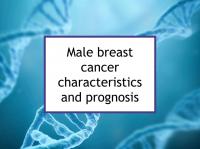While still rare (~1% of total cases), rates of male breast cancer have been increasing along with rates of obesity and exposure to endocrine disruptors (from packaged foods, personal care products, and industrial and environmental sources). Most cases of male breast cancer appear to resemble that of hormone receptor positive (ER+/PR+) female breast cancer.
There are some male breast cancer risk factors, such as BRCA mutations, an undescended testicle, Klinefelter syndrome, CHEK2 mutation, and Cowden syndrome, that are not primarily hormonally derived.
The breast cancer risk in men with BRCA2 mutations is 7.1% by age 70 and 8.4% by age 80 years, according to one study. Another study reported that 10% to 15% of men with breast cancer have a BRCA2 mutation and that approximately 5% to 10% of male BRCA2 carriers will develop breast cancer during their lifetimes. Men with BRCA1 mutations also have a somewhat higher risk of breast cancer than the general population. Use of the heart medication digoxin (digitalis) has been found to increase risk of breast cancer in men. Obesity, red meat consumption and alcohol use are also risk factors for male breast cancer.
Male breast cancer characteristics
Male breast cancer is most often invasive ductal carcinoma and hormone receptor positive, a profile that is not among the most aggressive. However, since men are not normally screened for breast cancer, their tumors are often large when found and may have nipple or skin involvement. At this stage, they are less treatable than they would have been if found early. Age at diagnosis tends to be higher in men than women (median 67 years of age for men compared to 61 years for women in one large U.S. study) and men are more likely to have positive lymph nodes. The most common presentation of male breast cancer is a palpable breast mass. However, men are more likely to present with nipple discharge than women. This symptom should lead to thorough evaluation for breast cancer in a man who experiences it, whether or not the discharge is bloody.
Male breast cancer treatment
Most men with breast cancer are treated with a mastectomy (possibly followed by radiotherapy) and systemic treatment such as chemotherapy and/or anti-estrogen treatment (typically tamoxifen). The most common serious side effects of tamoxifen in men are weight gain, sexual dysfunction and the development of blood clots. Breast conservating surgery (lumpectomy) is increasingly being used for men under appropriate circumstances. In that case, it is important that surgery be followed by radiotherapy.
One 2020 study reported that use of chemotherapy was associated with improved survival among men with progesterone receptor negative (PR-) breast cancer. Among men with PR+ breast cancer, only those with stage II or stage III disease saw significantly better outcomes associated with chemotherapy.
Male breast cancer prognosis
Like women, men with hormone receptor negative tumors (most of which are triple negative (ER-/PR-/HER2-)) have a worse prognosis than men with other breast cancer subtypes. In addition, men with triple negative disease have been found to have worse outcomes than women with triple negative disease.
Weight gain is common during treatment, including chemotherapy and tamoxifen. However, weight gain during treatment has been found to be associated with less favorable prognosis in women, even among those who are not initially overweight, and is to be avoided.
Although one study has reported that smoking is not a risk factor for male breast cancer, cigarette smoking tends to worsen prognosis. Men who continue to smoke after diagnosis have poorer survival — the more smoking, the worse the outcomes. A previous history of smoking also tends to worsen survival compared to never smoking.
A 2024 study reported that in men with stage I to III ER+/PR+ breast cancer, the risk of death from breast cancer lasts for at least 20 years depending on factors such as age, tumor stage, and tumor grade. The cumulative 20-year risk of breast cancer-specific mortality was 12.4% among men with stage I, 26.2% for stage II, and 46.0% for stage III.
Another large U.S. study reported that men with breast cancer survive for a median of nine years. The five-year survival rate was 63% and 10-year survival was 43% (mortality was often from causes other than cancer given the age of the men at diagnosis). Higher age at diagnosis, large tumor size, positive lymph node status, ER- status and poorly differentiated grade each were independently associated with decreased survival. African-American men experienced shorter survival (median 7.08 years) after diagnosis than non-Hispanic white men (9.2 years).
Still another study reported that for men initially diagnosed with stage II, median cancer-specific survival was 12.9 years; for stage III it was 7.2 years, and for stage IV it was 0.8 years. A small 2016 study reported that male breast cancer patients with harmful BRCA mutations had less favorable long-term survival rates than men without such mutations.
Please see also Male breast cancer survival data and Protecting our sons from breast cancer.
